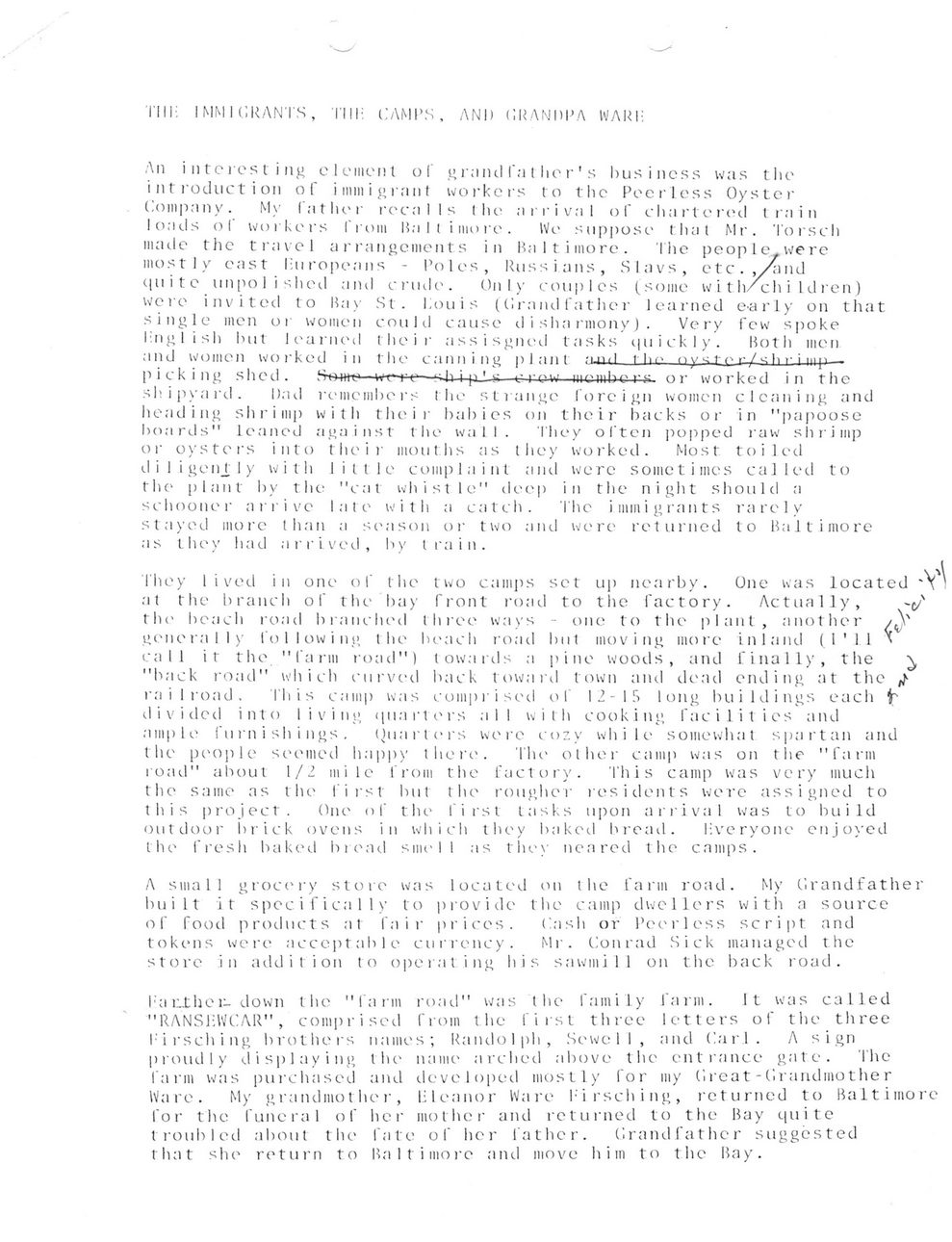This text was obtained via automated optical character recognition.
It has not been edited and may therefore contain several errors.
tin; immigrants, tin: camps, and grandpa wari: An into re s t i ng element ol g rand I a I lie r ' s business was the introduction of immigrant workers to the Peerless Oyster Company. My lather recalls 1 lit' arrival of chartered train loads ol workers I i oiii 15a I t imore. We suppose t hat Mr. Torsch made the travel arrangements in Baltimore. The people were mostly east liuropeans - Poles , Russians, Slavs, etc.y/and quite unpolished and crude. Only couples (some with/children) were invited to Hay St. I.ouis (.Grandfather learned early on that single men or women could cause disharmony). Very few spoke l.nglish hut learned their assisgned tasks quickly. Both men and women worked in the canning plant i lw> ny ^ t- n >-y ^ I' >? i mp ? (licking shed. vSemtt??wr-re- r.h-i-p-'s?e-ro-w?rx. or worked in the shipyard. Dad rememhers the strange foreign women cleaning and heading shrimp with their hahies on their backs or in "papoose hoards" leaned against the wall. They often popped raw shrimp or oysters into their mouths as they worked. Most toiled diligently with little complaint and were sometimes called to the plant hy the "cat whist le" deep in the night should a schooner arrive late with a catch. The immigrants rarely stayed more than a season or two and were returned to Baltimore as they had arrived, hy train. They lived in one of the two camps set up nearby. One was located at the branch of the hay front road to the factory. Actually, the heach road branched three wavs - one to the plant , another /^V general Iy fo 1 lowing the heach road hut moving more inland (I'll ' call it the "farm road") towards a pine woods, and finally, the ^ "hack road" which curved hack toward town and dead ending at the ^ rai I road. This camp was comprised of 12- IS long buildings each fr' divided into living, quarters all with cooking, facilities and ample furnishings. Quarters were cozy while somewhat spartan and the people seemed happy there'. The other camp was on the "farm road" about 1/2 mile from the factory. This camp was very much the same as the first hut the rougher residents were assigned to this project. One of the first tasks upon arrival was to build outdoor brick ovens in which they baked bread. liveryone enjoyed the fresh baked biead smell as they neared the camps. A small grocery store was located on the farm road. My Grandfather built it specifically to provide the camp dwellers with a source of food products at fair prices. (.ash or Peerless script and tokens were acceptable currency. Mr. Conrad Sick managed the store in addition to operating his sawmill on the back road. I;ai:.thei- down the "farm road" was the lamily larm. It was called "RANSMWCAR?, comprised from the first three letters of the three I?irsching brothers names; Randolph, Sewe 1 I , and Carl . A sign proudly displaying the' name arched above the entrance gate. Ihe farm was purchased and developed mostly lor' my Great-Grandmother Ware. My grandmother, lileanor Ware I'irsching, returned to Baltimore* for the funeral of her mother and returned to the Bay quite troubled about the fate of her lather. Grandfather suggested that she return to Baltimore and move him to the Bay.

Firsching 022